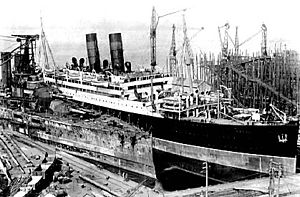RMS Andania (1913)

RMS Andania at Scott's Yard alongside HMS Ajax (1912)
|
|
| History | |
|---|---|
| Name: | RMS Andania |
| Owner: | Cunard S.S.Co Ltd, Liverpool |
| Builder: | Greenock Dockyard Company by Scotts Shipbuilding and Engineering Company Ltd |
| Yard number: | 446 |
| Launched: | 22 March 1913 |
| Completed: | 13 July 1913 |
| In service: | |
| Fate: | Sunk by torpedo from U-46 27 January 1918 |
| General characteristics | |
| Class and type: | passenger and cargo ship |
| Length: | 158.58 m (520 ft 3 in) |
| Beam: | 19.50 m (64 ft) |
| Installed power: | eight quadruple-expansion engines |
| Propulsion: | twin propellers |
| Speed: | 15 knots (28 km/h; 17 mph) |
| Capacity: | 520 second-class and 1,540 third-class passengers |
RMS Andania was a passenger and cargo ship from Great Britain launched 22 March 1913. She was 13,405 tons and built in the Greenock Dockyard Company by Scotts Shipbuilding and Engineering Company Ltd and completed 13 July 1913.
In World War I the Andania was used to transport the Royal Inniskilling Fusiliers and Royal Dublin Fusiliers to Cape Helles for the landings at Suvla. The landing at Suvla Bay by the British IX Corps was part of the August Offensive during the Battle of Gallipoli.
The Andania measured 158.58 by 19.50 meters (520.3 ft × 64.0 ft) and had twin funnels and masts. The hull was made of steel and the vessel was propelled by a twin propellers configaration, powered by eight quadruple-expansion engines creating a service speed of 15 knots. The Andania held accommodations for 520 second-class and 1,540 third-class passengers. Her sister ships were the Alaunia and Aurania which were almost identical and "cater(ed) only for second and third class passengers. The old-style third class dormitories were replaced by four or six-berth cabins."
The Andania made its maiden voyage on 14 July 1913 from Liverpool via Southampton to Quebec and Montreal. In August 1914 it was requisitioned as a troopship and made several trips carrying Canadian troops. For a few weeks in 1915 the Andania was used to accommodate German POWs in the Thames. In the summer of 1915 it was used in the Gallipoli campaign when she was used to transport the Royal Inniskilling Fusiliers and Royal Dublin Fusiliers to Cape Helles for the landings at Suvla.
...
Wikipedia
